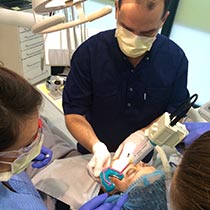Throughout the duration of the dental treatment you are in an unconscious sleep, but in an artificially preserved state. You may feel and realize nothing. When the dental procedure is completed, the specialists wake you up and remove the breathing tube before you are fully back to consciousness. Thanks to modern drugs, you can be fully awake in no time. The anaesthetist and assistant monitor the full awakening until it meets the requirements of the decree protocol. You get a full explanation of what to do after the dental anaesthesia. You receive the instructions and, if necessary, also the prescription of the medications.
How long does a dental anaesthetic last?
The semi-anesthesia we use usually lasts 1-3 hours, but the duration can vary, as many factors influence it. Your metabolism, weight, and general health can affect how your body processes the anaesthetic. Different anaesthetic drugs have different durations of action. For your complete safety, we ask that you always come with a companion for the dental treatment performed under anaesthesia.
Dental anaesthesia side effects
Although rare, some people may experience temporary side effects such as dizziness, headache, or muscle twitching. If you have any concerns about the duration of anaesthesia or experience any unusual side effects, please do not hesitate to contact our dentist.
How much does anaesthesia cost?
A semi-anesthesia costs 450£ in our clinics.
Our customers most often request anesthesia in these cases: dental implant proceduret, all on 4 dental implants, dental bone graft




 does not experience any discomfort in the larynx or nose after the anaesthesia. He soon regains consciousness and walks on his own two feet. He receives intravenous medication while we monitor his heart and respiratory functions. General Anesthesia: This puts you in a deep sleep and is usually reserved for complex procedures or patients with severe anxiety. It carries the highest risk but is still considered safe when administered by trained professionals with proper monitoring.
does not experience any discomfort in the larynx or nose after the anaesthesia. He soon regains consciousness and walks on his own two feet. He receives intravenous medication while we monitor his heart and respiratory functions. General Anesthesia: This puts you in a deep sleep and is usually reserved for complex procedures or patients with severe anxiety. It carries the highest risk but is still considered safe when administered by trained professionals with proper monitoring.
 We will need you to fill out a medical history form that you should e-mail us. If you have indicated to us that you would like to have your treatment under full dental anaesthesia, we will send you the necessary medical history form by e-mail. After that, the anaesthetist will decide which examinations must be carried out and whether you are allowed to have dental anaesthesia. The examinations can be carried out either in your home country (this has the advantage that the majority of the possible reasons that could be against anaesthesia will be discovered before the trip) or in Hungary with us (this will lengthen your treatment time by 1-2 days).
We will need you to fill out a medical history form that you should e-mail us. If you have indicated to us that you would like to have your treatment under full dental anaesthesia, we will send you the necessary medical history form by e-mail. After that, the anaesthetist will decide which examinations must be carried out and whether you are allowed to have dental anaesthesia. The examinations can be carried out either in your home country (this has the advantage that the majority of the possible reasons that could be against anaesthesia will be discovered before the trip) or in Hungary with us (this will lengthen your treatment time by 1-2 days). 1. After the doctor who carries out the examinations has stated that everything is ok with you and has provided you with preliminary advice (e.g. medication), you show up to the appointment at your clinic in Hungary with your own personal assistant.
1. After the doctor who carries out the examinations has stated that everything is ok with you and has provided you with preliminary advice (e.g. medication), you show up to the appointment at your clinic in Hungary with your own personal assistant. After the anesthesiologist has answered all your possible questions, you sign the anaesthesia consent form. If you do not sign it, we are not allowed to perform dental anaesthesia.
After the anesthesiologist has answered all your possible questions, you sign the anaesthesia consent form. If you do not sign it, we are not allowed to perform dental anaesthesia.